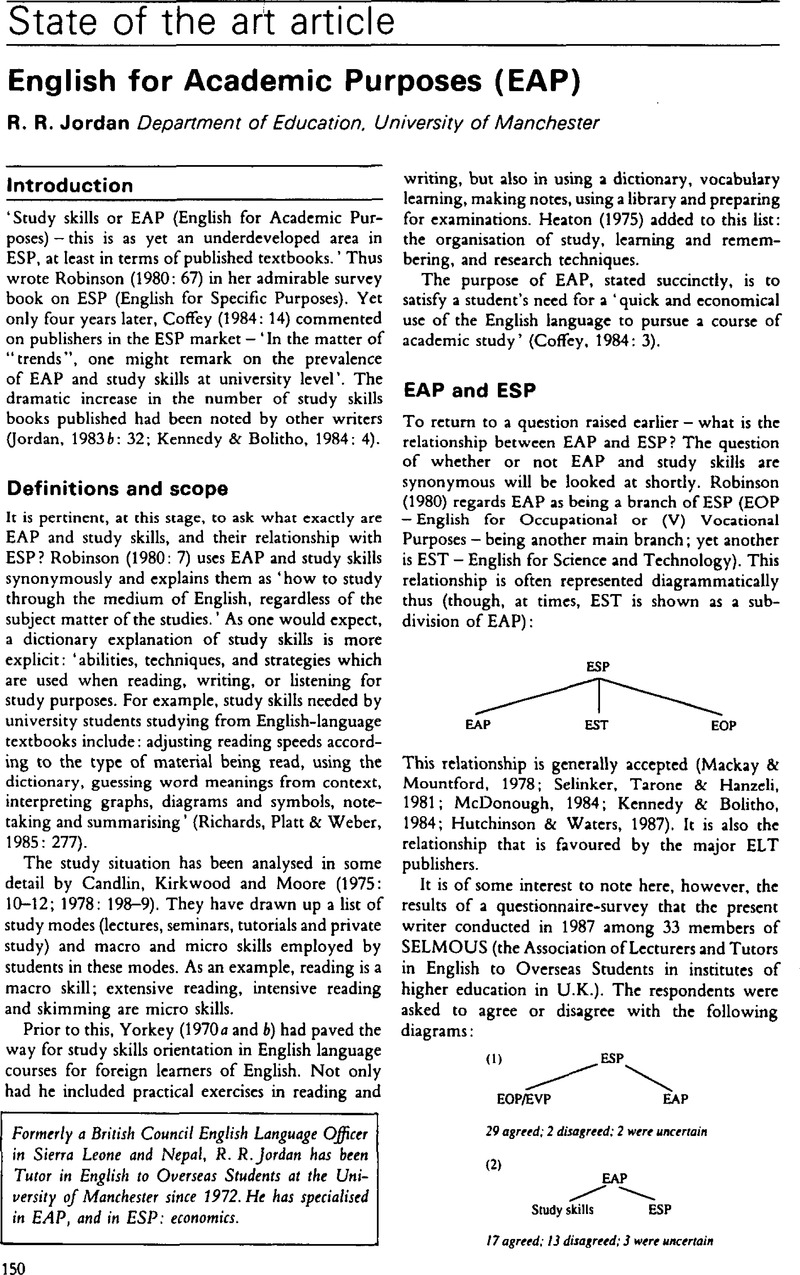Crossref Citations
This article has been cited by the following publications. This list is generated based on data provided by Crossref.
Bourke, Sid
and
Holbrook, Allyson
1992.
University Students' Writing: Types of Errors and Some Comparisons Across Disciplines.
Higher Education Research & Development,
Vol. 11,
Issue. 2,
p.
119.
Paltridge, Brian
1993.
Writing up research: A systemic functional perspective.
System,
Vol. 21,
Issue. 2,
p.
175.
Jarvis, Huw
1997.
The role of IT in English for Academic Purposes: a survey of provison on presessional courses at British universities.
ReCALL,
Vol. 9,
Issue. 1,
p.
43.
Basturkmen, Helen
1999.
Discourse in mba Seminars: Towards a Description for Pedagogical Purposes.
English for Specific Purposes,
Vol. 18,
Issue. 1,
p.
63.
Clapham, Caroline
2000.
Assessment for academic purposes: where next?.
System,
Vol. 28,
Issue. 4,
p.
511.
Kok, Anton
and
Nienaber, Annelize
2005.
Legal skills for first‐year law students: Too little, too late?.
The Law Teacher,
Vol. 39,
Issue. 2,
p.
161.
신창원
2012.
The Compilation of a Small Corpus for ESP Teaching: A Special Corpus of Research Paper Abstracts in Mechanical Engineering Domain.
Language & Information Society,
Vol. 17,
Issue. null,
p.
175.
Davoudi-Mobarakeh, Sajad
Eslami-Rasekh, Abbas
and
Barati, Hossein
2014.
Teachers’ Feedback and Students’ Motivation in English for General and Specific Purposes Courses in Iran.
Theory and Practice in Language Studies,
Vol. 4,
Issue. 5,
Anderson, Rob
2014.
A Parallel Approach to ESAP Teaching.
Procedia - Social and Behavioral Sciences,
Vol. 136,
Issue. ,
p.
194.
Willans, Fiona
2016.
Carving out institutional space for multilingualism in the world’s most multilingual region: the role of Linguistics at the University of the South Pacific.
Current Issues in Language Planning,
Vol. 17,
Issue. 3-4,
p.
351.
Ding, Alex
and
Bruce, Ian
2017.
The English for Academic Purposes Practitioner.
p.
53.
Kustati, Martin
Hallen
Qismullah Yusuf, Yunisrina
Al-Azmi, Hidayat
and
Hanifa, Dini
2020.
EAP NEED ANALYSIS FOR LECTURERS: THE CASE OF A STATE ISLAMIC UNIVERSITY IN PADANG, INDONESIA.
Humanities & Social Sciences Reviews,
Vol. 8,
Issue. 3,
p.
64.
Rieder-Bünemann, Angelika
and
Resnik, Pia
2021.
Developing Advanced English Language Competence.
Vol. 22,
Issue. ,
p.
215.
Wang, Guanghua
2022.
Exploring Evaluation Principles for English for Academic Purposes (EAP) Textbooks.
p.
134.
Zehir Topkaya, Ece
and
Çelik, Handan
2024.
Teaching English for Academic Purposes.
p.
3.
Mumford, Simon
and
Dikilitaş, Kenan
2024.
Teaching English for Academic Purposes.
p.
39.
Sun, Jiping
2024.
Conceptual divergence and its causes in English for academic purposes abroad from the perspective of legitimation code theory.
International Journal of English for Academic Purposes: Research and Practice,
Vol. 4,
Issue. 2,
p.
129.
Basturkmen, Helen
2025.
Core Concepts in English for Specific Purposes.



